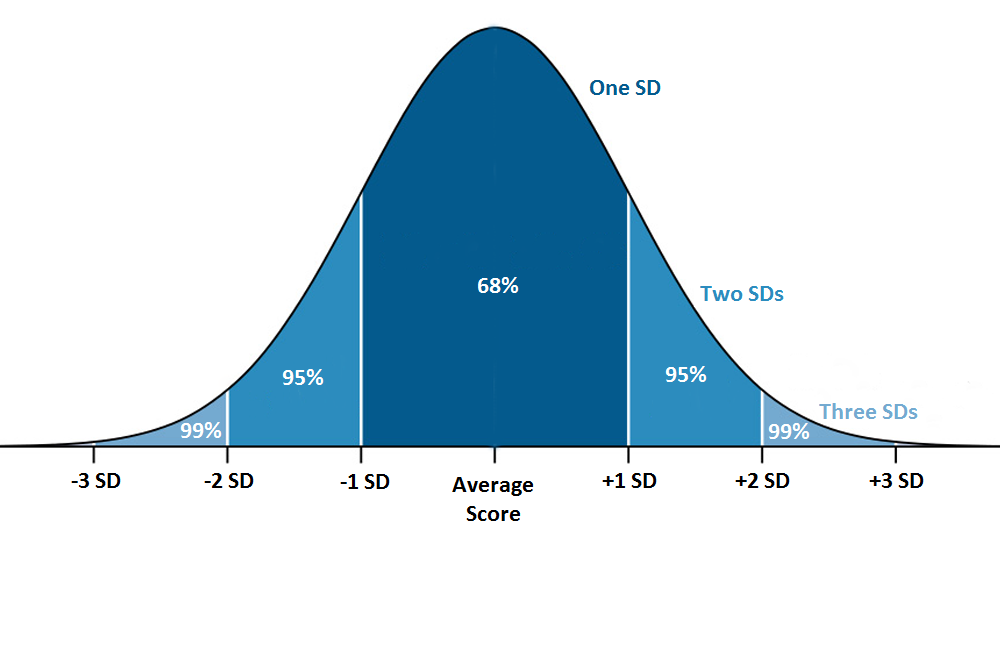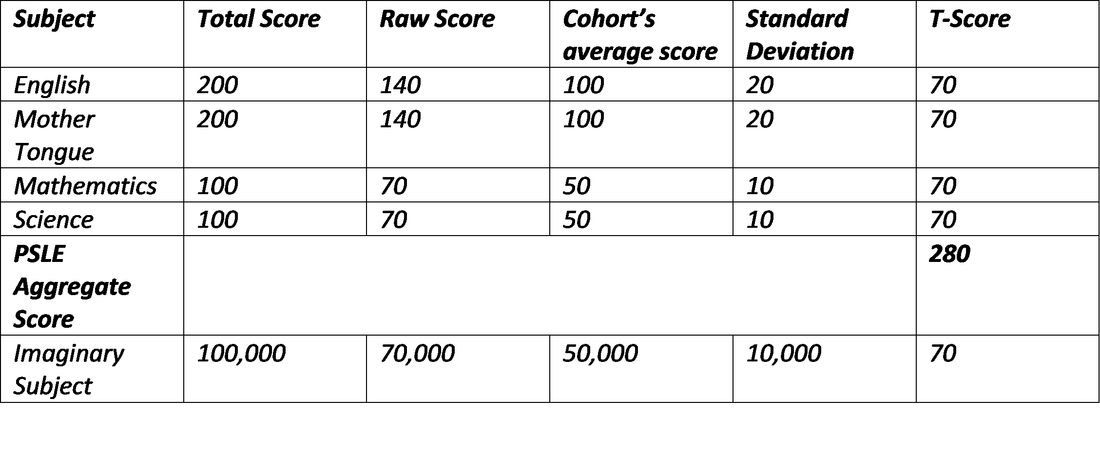Your comprehensive Guide to How PSLE Scoring is Done, and the Most Important Consideration!6/4/2018 How are PSLE aggregate scores calculated? What does my child's PSLE scores mean? Why did my child get low PSLE scores even though she got straight As? My child always gets full marks on her tests. That means she would/should have gotten a full PSLE score right? These are some questions we often receive about PSLE scoring. Here, we shed some light on how your child's PSLE Aggregate Score is calculated and address some common misconceptions! We also point out the most important consideration when thinking about PSLE scoring! HOW PSLE SCORING IS DONE Overview The short story is as such: Step 1: Your child takes the PSLE examinations. Her marks for each subject are her raw scores. Step 2: A T-score is calculated for each subject based on her raw score. Step 3: The T-scores are summed (aggregated). The total is your child's PSLE Aggregate Score! We explain this process in detail below! Step 1: Obtaining Raw Scores This step requires no explanation. Your child sits for the PSLE examinations, does her best, and the marks she obtains are her raw scores! Step 2: Calculation of T-scores To understand PSLE Scoring, we must first understand that a statistic called the T-score is used to calculate the aggregate score. The T-score is not the same as a raw score! Remember, the raw score is simply the marks your child obtained in her PSLE examination. In contrast, the T-score is a comparative score that reflects how well she did relative to her cohort. It is calculated using a formula that compares her raw score to the cohort's average raw score. It also takes into account how spread out the raw scores of the cohort are. The formula of the T-Score is: T = 50 + 10(X-Y)/Z
T = 50 + 10 x (90-75)/10 = 50 + 10 x 15/10 = 50 + 15 = 65 Wait! What is Standard Deviation?! The Standard Deviation (SD) is a statistical measure for the amount of spread of the results from the average. The bigger the SD, the larger the spread. A simple way to read SD is as such:
For example: Suppose the cohort's average is 75, the Standard Deviation is 15, and 10000 students took the PSLE examinations. This means that:
The PSLE score is formed simply by aggregating (adding up) your child’s T-scores across the subjects taken. And there you have it, the PSLE Aggregate Score! CHANGES TO PSLE SCORING IN 2021 What we explained here will only be relevant for another 3 years! On 13 July 2016, MOE announced that eight scoring bands, or Achievement levels (ALs), will replace the current PSLE T-score system in 2021. WHAT IS THE MOST IMPORTANT CONSIDERATION IN PSLE SCORING? The answer is straightforward – it is step 1! More specifically, the most important thing is for your child to give her best during her PSLE examinations – all the other steps are merely calculations based on what she obtains and are beyond her control. We strongly encourage parents not to be too absorbed in or distracted by the details of PSLE scoring. The best thing you can do is to focus on helping your child to do her best! We will be talking more about this in an upcoming post on shaping your child’s goals and motivation to excel by encouraging effort, not results, so keep checking back for more content! WAIT! I STILL HAVE MORE QUESTIONS! Sure! We address some common questions and misconceptions here: 1. My child can get 300 for her PSLE if she scores 100 marks for all her exams, right? It may seem strange, but a child who scores full marks for all her exams may not get a PSLE aggregate score of 300! To see how that works, suppose John scored 100 on all 4 subjects. The cohort’s average was 70 with an SD of 15: T (for each subject) = 50 + 10 x (100-70)/15 = 50 + 10 x 30/15 = 50 + 20 = 70 PSLE Aggregate Score = 70 x 4 subjects = 280 It all depends on the average score and spread of scores! 2. My child got all As or A*s but got an aggregate score of only 220! What is going on?! There is no information available about how the letter grade banding is precisely done. Nonetheless, what we do know is that the letter grade issued for a subject is based on your child’s raw score; it does not take into account how your child did relative to her cohort. In contrast, the PSLE aggregate score is derived from T-scores, which compares your child to her cohort as explained above. It may be that your child did well in the PSLE examinations in terms of raw scores, and therefore obtained good letter grades, but the cohort as a whole did exceptionally well, thus pulling down her aggregate score. To illustrate this, suppose Grace scored 80 marks across all four subjects. If the cohort’s average across all four subjects were 75 with an SD of 10: T (for each subject) = 50 + 10 x (80-75)/10 = 50 + 10 x 5/10 = 55 PSLE Aggregate Score = 55 x 4 subjects = 220 If the cohort’s average across all four subjects were 70 with an SD of 10: T (for each subject) = 50 + 10 x (80-70)/10 = 50 + 10 x 10/10 = 60 PSLE Aggregate Score = 60 x 4 subjects = 240 Thus, Grace would have gotten the same letter grades across the cohorts as they are based on her raw scores, but different PSLE aggregate scores as they are affected by how well the cohort did! If the cohort is weaker, her PSLE aggregate score goes up! 3. Can you help me estimate my child’s PSLE score? She usually gets (so and so) marks. Unfortunately, this would be very difficult as the PSLE scores will be significantly different based on the performance of the cohort. As we saw in Question 2, a small shift in the cohort’s average can create a big difference in the PSLE aggregate score. A very rough method for estimation will be to add the raw scores together and multiply the result by ¾. For example, if Sophie’s raw scores are 90 for English and Mathematics, 70 for Science and 65 for Chinese, the estimate for her PSLE score would be (90+90+70+65) x ¾ ≈ 236. The basis for this method is that firstly, the PSLE examination is well designed such that the scores for each subjects are sufficiently distributed across a normal distribution; and secondly, the results are moderated through the Standard Deviation into T-scores. Do note that this is a very rough estimation! 4. My child is exempted from Mother Tongue. How will her T score be calculated? If a student is exempted from Mother Tongue, her T-score for her remaining three subjects will be used to compute an aggregate score. However, the computation will be different from a student who takes all four subjects. For a student without exempted subjects, her PSLE Aggregate Score is computed by summing of her T-scores for the four subjects. For a student with exempted subjects (e.g., Mother Tongue), the total T-score for the remaining subjects taken (e.g., English, Mathematics and Science) will be statistically adjusted. It is not a simple summing of scores, as this would cause her PSLE Aggregate Score to be very low! The method of adjustment is unclear, but is done in a way that her PSLE Aggregate Score will be comparable to her peers who had taken Mother Tongue and obtained T-scores that are comparable to her English, Mathematics and Science. In other words, the non-exempted students who performed similar to her are used as a proxy to compute her overall PSLE Aggregate Score. 5. What is the average PSLE score in (year)? The average PSLE score across the years should be 200. This is because the average T score for every subject will always be 50. To see how this works, we go back to the T-score formula: T = 50 + 10 x (Raw Score – Cohort’s Average Score)/SD So if the raw score of the pupil = average score of the cohort, = 50 + 10 x (0)/SD = 50 + 0 = 50 PSLE Aggregate Score = 50 x 4 subjects = 200 6. The total score for English and Mother Tongue subjects are 200 marks each while the total score for Mathematics and Science are 100 marks each. Does that mean English and Mother Tongue subjects twice as important as Mathematics and Science since they have twice the weightage? This is a common misconception. Remember, the PSLE aggregate score is calculated by summing T-scores, and the T scores compare the raw scores to the cohort’s average, taking into account the spread of scores. The differences in volume of marks for the subjects will be eliminated by the calculation of T-scores. For example, We see that the raw score is 70% of the total marks, cohort’s average score is 50% of the total marks and SD is 20% of the total marks across all subjects. In the end, the weightage of each subject is the same across all subjects even though the total marks differ! We also added an imaginary subject above to illustrate the point – even though the total marks are 100,000, using the same percentages for the raw score, average score and SD, the T-score is still 70! The T-score therefore automatically adjusts for any differences in the volume of total marks across subjects. 7. Is the same SD used for all subjects? The SD is calculated for each subject, based on the cohort’s scores for the subject. For example, the SD for English cannot be used for Mathematics because it is calculated based on the cohort’s scores for English. A closing note As we have mentioned earlier, PSLE scoring should mean little to your child's studies and the most important thing is (and has always been) for your child to give her best during her PSLE examinations! At Polymath Learning Centre, we believe that the focus of education should be to nurture the character, aptitude and attitude of children to give them the best chances of success in the future, not just in school but also in life. Good results and high scores are a natural consequence of successful education, not the other way around. The best thing we can do is to focus on helping your child to do her best! We discuss this further in our other blog posts so do give them a read. If you're curious to find out more about our approach, feel free to contact us or sign up for a free trial lesson today! |



 RSS Feed
RSS Feed